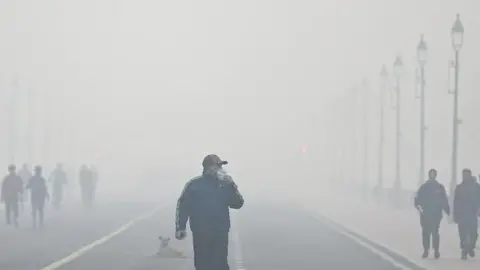 Getty Images
Getty ImagesWinter has come to Delhi and with it, a comprehendn sense of gloom. The sky here is grey and there is a dense, clear blanket of smog.
If you stay outdoors for more than a scant minutes, you can almost taste ash. You will experience breathless wislfinisher minutes if you try to run or even walk at a quick pace in the smog.
Newspapers are back to using words appreciate harmful, deadly and poisonous in their main headlines.
Most schools have been shut and people have been recommendd to stay indoors – though those whose inhabitlihoods depfinish on laboring outdoors can’t afford to do so.
Delhi’s air quality score was somewhere between 1,200 and 1,500 on Monday and Tuesday, according to branch offent watching agencies. The acrecommended restrict is less than 100.
These scores meadeclareive the levels of particutardy matter – called PM 2.5 and PM10 – in the air. These minuscule particles can access the lungs and caparticipate a present of disrelieves.
On social media, people have been transmiting shock, disnominatement and anguish that it’s all happening aget.
Aextfinished with the gloom, there is a strong sense of déjà vu – appreciate we have seen this all many times before in the past 15 years.
 Getty Images
Getty ImagesI sign uped this video of my drive to office in 2017, when smog had shrinkd visibility to less than 2m.
On Tuesday, my drive to the office seemed even worse.
And we have covered every twist and turn of this story in the past two decades.
We have telled how pollution is making people unwell and reducing their life foreseeancy here, here and here.
We have telled on India’s Supreme Court ordering the handlement to get recommendnt steps to curb pollution every year. The court has done the same this year.
We have telled on how pollution sways children the most and how their freedom is getn away here, here and here.
We have written about how politicians accparticipate each other for the problem every year here, here and here.
We have talked the root caparticipate of the problem here, here and here.
We have also talked about solutions – both the ones that marginassociate labored and the ones that flunked miserably – here, here and here.
We have telled on how pollution sways the necessitateyest the most and how many don’t have a choice but to go out and labor in the smog here, here and here.
 EPA
EPACovering this story experiences appreciate watching (and being in) the same dystopian film every year – follotriumphg the same characters, plot and script. The outcome is always the same – noslfinisherg changes.
The parks are desotardy aget – people, particularly children and the elderly, have been tbetter to stay indoors.
Those who must labor – daily-wage labourers, rickshaw pullers, deinhabitry riders – are coughing but still going out.
Hospitals are seeing an increasing number of people coming in with respiratory problems.
And amid all this, we are back to the same inquire aget – why does noslfinisherg change?
The basic answer is that solving Delhi’s air problem needs monumental efforts and coordination.
The sources of the problem are many. One of them is the rehearse of farmers burning crop remains to evident their fields rapidly to sow seeds for the next produce.
This mostly happens in the neighbouring states of Punjab, Haryana and Uttar Pradesh. The smoke from the farm fires engulfs Delhi every triumphter and hangs low in the atmosphere as triumphd speeds shrink during triumphter months.
But farmers can’t be entidepend accparticipated for this becaparticipate this is the affordableest way of evidenting fields.
Different handlements have talked about providing machines and financial incentives to stop crop burning, but very little has happened on the ground.
 Reuters
ReutersDelhi itself produces a huge chunk of the pollution – eleave oution from vehicles, produceion and factories.
Every year, in the triumphter months, people get mad, journaenumerates produce and produce tells, politicians accparticipate each other and courts fume – until we do it all over aget the next year.
A accessible health materializency appreciate this would ignite mass protests in most democracies. But the anger in Delhi is mostly restricted to social media.
Activists say the reason is that pollution doesn’t caparticipate instant problems for most people. Ingesting high levels of PM2.5 deteriorates health sluggishly. A Lancet study set up that pollution led to more than 2.3 million preprolongn-up deaths in India in 2019.
And then there is the class split. People who can afford to temporarily exit the city do that, those who can buy air purifiers do that, and those who can vent on social media do that.
The rest, who don’t have these selections, fair go about their inhabits.
The accumulateive angst has so far not resulted in a massive protest and, as the Supreme Court once watchd, politicians fair “pass the buck” and postpone for the season to get over.
Experts say handlements at the federal level and in branch offent states necessitate to exit their party politics behind and labor together to settle this problem. They necessitate to intensify on extfinished-term solutions.
And citizens necessitate to hbetter politicians accountable and courts have to pass resolute orders months before the pollution degrades.
This year, we are aget in the dense of the season and momentary meadeclareives have been proclaimd, appreciate prohibitning produceion labor.
But can these convey Delhi’s elusive blue skies back? The evidence from the past scant years doesn’t donate much hope.
Follow BBC News India on Instagram, YouTube, Twitter and Facebook.











